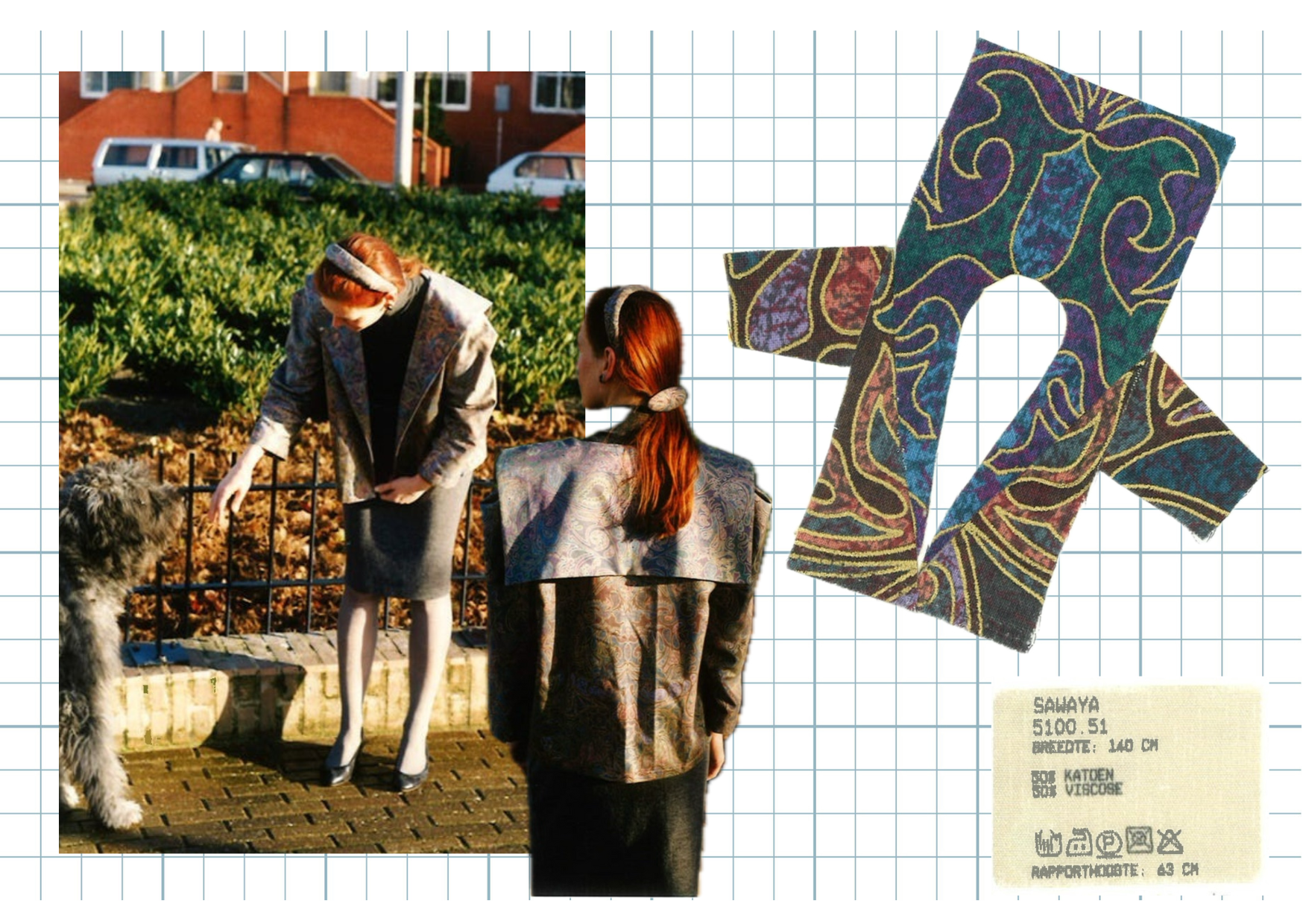The Mop Jacket


Introduction
Charlotte: “Yes, this jacket is made from a floor mop material, but in my defense, they just looked too nice to be declared rags. I love the rough texture of the fabric and the thick feel. Despite having an original purpose for cleaning, it gives a chic and expensive feel. I’d been obsessing over the fabric in my mom’s atelier for weeks. When we finally figured out a plan for what to do with it, recreate my mom’s sailor jacket from the 80s.
Big, bold, and beautiful!

It made me think about leftover processing and finding ways to re-evaluate our trash. There are enough clothes produced for the next 7 generations. Which means there are tons of deadstock. But because we lack a system or platform of transparency about these unused products, we can’t revive them and create new things with what’s already there.
Leftovers can be art, and we shouldn’t be afraid to frame our rags!”
The Pattern
Martine: “At the beginning of the eighties, I found myself in yet another new school, this time in suburbia. While mostly occupied with getting my pre-university requirements sorted out, my greatest pleasure was to withdraw into my hobby: sewing.
Sewing and fashion were something I shared with a girl from biology class. When she showed up in a jacket made from neon green tulle, I complimented her. She shared the pattern by (hand!) copying it. (Thank you, Corinne <3. If you want credit, let me know. I forgot your last name, so I couldn’t trace you on the web.) It must have been around 1982. We probably exchanged tips and patterns more often, but unfortunately, I don’t remember other details.

In the years that followed, I sewed this jacket several times using curtain fabric, denim, and other materials. Not just for myself, but also for friends. I modified the big sailor collar in several ways, as the pictures show. For this editorial version, we modified the original collar and the length of the jacket.”
The Fabric
Then, a year ago, Charlotte asked me to sew the jacket for her using some very old cleaning cloths we had found in her grandmother’s house. I remember her being completely charmed by the rough material and the patterns on those cloths. Unfortunately, it wasn’t enough for the full pattern, and I remember her sitting for ages, trying to make the pieces fit inside the pattern.
That’s when I shared another golden rule from my textile upcycling career: when in doubt, add jeans.

She immediately lit up, and luckily, we had a piece of the perfect denim to finish the jacket. Which also came from her grandmother's collection. You can check the pictures and decide for yourself if it worked.
I wasn’t sure the idea would translate well, so I made a prototype first, also called a muslin. We decided the cut suited her well, but we adjusted the length and shortened the collar. You can make this jacket from virtually any fabric, but I must agree with Charlotte that a thicker fabric gives it a chiquer feel.”
The Execution
“Want to make your own version? You can buy the pattern and instructions [via this link]. I have written some instructions. If you just follow them step by step, you can definitely do it! The collar looks more complex than it is. I can sew an easy version in just over an hour. I’d say it’s a moderately easy pattern.
You can generally make it more complicated by using a bunch of different and less coherent materials. For example, the jeans and the fact that the mops could only fit the pattern in one specific angle made it a bit more difficult. If you use one fabric for the entire jacket, it will be easier to make them work together.
Another golden rule: just start and don’t overthink it!

But if you’re thinking of using expensive material, I highly recommend first making a muslin (a test version) to check the fit and get a feel for the pattern. Maybe you have some leftover fabric at home that can serve as a mock-up. Old sheets normally also do the trick quite well.
The techniques used for this jacket are accessible, but the complexity lies in how the lapel connects. Once to the front panel and once to the top collar. Within the pattern, I’ve added some special symbols that will make the process much easier.
Even though I think this is quite a manageable pattern, I’d love to hear how you experience the process and if my instructions hold up. The pattern also leaves room for iterations. Charlotte’s jacket has a shorter collar. I’ve made a round collar version, and you can change the sleeves and length if you want. I can’t wait to see what you come up with!”
The Styling
Charlotte: "Styling this jacket is a breeze thanks to the jeans sleeves and back panel. I wore it for the Meuck pitch on the radio (link here, start at 15:40), and I get compliments every time I wear it (not that it matters ;)).
It’s easy to dress up with tailored pants or even wear to work when made with a different fabric. We made a matching vest to go underneath (the pattern and editorial for that are coming soon), but you can also close the jacket with a brooch or something else playful. On our TikTok, you can find a styling video and a video about the creation process.
As always: endless possibilities. We’d love to see what you create and how you style your own Mop Jacket. Share your story and photos with us, so we can share them on our platforms! And remember: your next favorite jacket might already be hiding in your cleaning closet."
Excited to try this pattern yourself? You can get it here!






